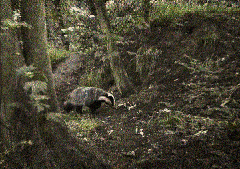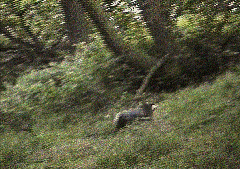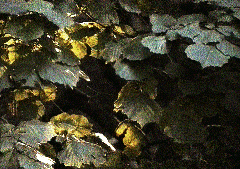Where are this year’s cubs from the Quesse Wood clan?
Across a field is another wood, nameless on the maps, split by the road coming from the swing bridge across the river. As usual for small Cheshire woods, it fills a small valley which opens onto the flood plain of the Pettypool Brook, a small stream which runs into the river just downstream of the swing bridge. Near the mouth of the valley was a small sett, just two holes, and I have always believed it to be an outlying sett of the Quesse Wood clan, since the year when I found it, a long time ago. There is a badger run across the road, usually well-used, and less than half a mile between the outlier and the main sett. Can it be that the female in milk that I saw at the main sett on one occasion was just visiting, and she then took her family back to the outlying sett?
Tonight I set off on my bike to test my latest theory. I bumped down the track to the river and crossed the swing bridge, the wooden beams making a distinctive rumble. Onto the road and across the Pettypool Brook, I bowled past the Old Mill with its refurbished mill wheel which is nowhere near the present course of the brook. This loops around behind the old black-and-white cottage in which Old Man Guntripp lived and died.
I puffed up the slope towards the wood and stopped at the top to check the wind direction before climbing the barbed wire into the wood. I quietly crossed to where the ground dropped away into the valley and hid the bike from view from the road, before moving down the slope as quietly as possible. There were dried-up beech leaves littering the ground, and I inevitably made some noise as I came down opposite the sett and settled behind a tree. The canopy was denser than Quesse Wood, and there was very little bird song to disturb an intense silence, so the rustle of the leaves announcing my arrival seemed more like a roll of drums.
Almost immediately, a black and white head appeared at the hole, and stared across the valley in my direction. The badger then came right out of the hole, and I could see that it was small, and had the characteristic bump on the nose above the eyes – it was a cub!
It wandered down the slope and climbed onto a fallen down tree which was lying in the boggy ground, which was all that was left of the stream, in the bottom of the valley. I had been lucky in choosing my spot, because the stump of the tree lay on the ground a few yards to my left. The cub walked and scrambled across the dead branches, and stopped beside me while he tested the air thoroughly. The wind had died and my scent must have been spreading out from me in all directions, but the cub had not learnt of any danger associated with human scent by experience or the example of adults, so he just shrugged his shoulders metaphorically and trundled off, climbing the valley side.
After a few minutes, a second cub emerged and immediately set off in the same direction, but when an adult came to the entrance ten minutes later, it considered the world outside with suspicion and went back down again. I watched a herd of cows drift past the mouth of the valley, then back in the opposite direction. A shire horse – those with the big feet – browsed a little amongst the trees and moved on. It was over half an hour later, with darkness falling and a flock of bats hunting up and down the valley in front of me, when an adult badger emerged and hunted a little in the vegetation at the valley bottom, while a second adult just came to the entrance and watched cautiously. When they both returned below, I left as quietly as I could.
The behaviour of both the cubs and the adults make me feel that they must have been up already when I arrived. Without disturbance, the family would surely have emerged together and engaged in the usual scratching and grooming activities that take place on a warm summer evening like that of today. My arrival must have sent them all down, and the adults behaviour was typically suspicious, but the cubs are old enough to ignore their grownups’ warnings and take their own counsel. How similar badgers are to humans sometimes!



